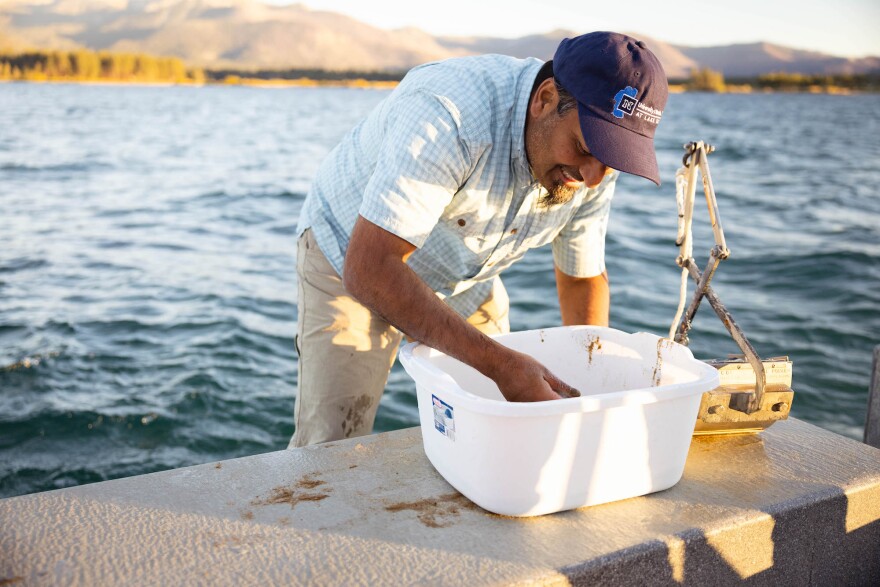On a cool, fall evening on Lake Tahoe, researcher Sudeep Chandra stands at the back of a small boat anchored in the south end of the clear blue lake. He’s holding a device called a dredge, which looks like a large metal clamshell.
“So, we’re basically going to drop this in the water,” Chandra says as he lightly tosses the dredge into the glassy lake and watches it sink to the bottom.
A few seconds later, after the device snaps shut and scoops up a sample of the lakebed, Chandra reels it in and cracks it open into a shallow bucket.
“We first see, of course, invasive Asian clams,” Chandra says, plucking a small shell from a pile of sediment. “These things can live two to four years old, and they can reproduce hundreds of thousands to millions of little villagers or tiny clams that go spread around the lake.”
Asian clams are an invasive species that showed up in Tahoe more than 20 years ago. They give off nitrogen and phosphorus that help algae grow, which degrades water quality.
Chandra, director of the University of Nevada, Reno’s Global Water Center, is looking for a different invader. It was discovered recently and is even smaller: the New Zealand mud snail.
“You can think about them being the size of the tip of your fingernail,” Chandra says.

But their invasion footprint can expand fast. That’s because these mud snails multiply by cloning themselves. One female can produce over 40 million offspring in a single year.
“And in any given lake or river, we might see 95% of the population is all the same clone,” Chandra says. “And so that allows them to colonize places pretty quickly.”
As a result, New Zealand mud snails can crowd out native species and eat up insects that fish rely on for food. This could threaten Tahoe’s native ecosystem, which is highly protected and an important economic driver in northern Nevada and California. The scenic waters and mountains draw people from around the world for boating, fishing, skiing – and Instagramming.
The risk of new invasive animals and plants taking hold is increasing around Tahoe and the entire world.
Andrew Kramer, a biologist at the University of South Florida, says the rise in global trade and travel is a big reason. Another is climate change.
“As places get warmer, there’s going to be a larger pool of species that are potentially able to survive there,” he says.
Kramer co-authored a 2022 study on the economic impacts of invasive species in America. The cost? About $22 billion per year. They can affect industries, damage infrastructure, and raise wildfire risks.
Kramer says the West is “the most affected region. And that’s some combination of agriculture and forestry, and the high value that people put on the natural resources out there.”
The New Zealand mud snail is among the thousands of invasive species impacting waters and lands in the West. Other examples include feral swine, cheatgrass, and the quagga mussel, a shellfish recently found in Idaho’s Snake River.
“We had biologists on the river within, really, 24 hours of receiving that information,” says Nic Zurfluh, bureau chief for the Idaho State Department of Agriculture’s invasive species program.
He says quagga mussels can clog water pipes used for tap water, farming and the state’s main electricity source: hydropower. “And so, every straw coming out of the river, every user, is impacted.”
Idaho officials recently spent $3 million to kill the invasive species, treating a section of the Snake River with a chemical hazardous to mussels. But they won’t know if the mussels have been wiped out until waters are sampled next spring.

Back at Lake Tahoe, Chandra says researchers are figuring out how much the mud snail invasion has spread – and how to control it.
“Another important question we need to ask ourselves now that we are infected at Lake Tahoe is, ‘What we can do to prevent the spread to other water bodies?’ ” Chandra says.
A lot of that will depend on locals and visitors. Invasive species can move from one water body to another by everything from boats to paddleboards to fishing gear.
That’s why it’s important, he adds, for people to clean, drain and dry their equipment.
This story was produced by the Mountain West News Bureau, a collaboration between Wyoming Public Media, Nevada Public Radio, Boise State Public Radio in Idaho, KUNR in Nevada, KUNC in Colorado and KANW in New Mexico, with support from affiliate stations across the region. Funding for the Mountain West News Bureau is provided in part by the Corporation for Public Broadcasting.
The first photo included in this story is licensed under Flickr Creative Commons.
Copyright 2023 KUNR Public Radio. To see more, visit KUNR Public Radio. 9(MDAwMzY5MzE4MDEzMTE3ODg5NDA4ZjRiNg004))





